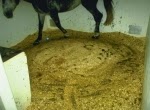So last week I wrote a blog 'Do horses get bored?' where I mentioned 'vices', 'bad habits' and 'stereotypies' . These behaviours seem to be more about the horse being stressed - although we (the horse community) have historically said these develop because a horse is bored!
So what is a vice?
Whatever you like to call them, they are annoying or damaging habits/behaviours that horses develop, often when they are stabled for long periods, isolated from their friends or even given an inappropriate diet.
Weaving
The horse swings his head and neck (and sometimes body) from side to side.
Difficult to see in a picture - but have a look on You Tube!
There are weaving bars available which prevent a horse from being able to do this whilst their head is over the door (some will just do it inside instead).
Crib-biting/Wind-sucking
These are similar. In wind-sucking the horse arches his neck and swallows air making a loud grunting noise. Whilst in crib-biting the horse does the same but grabs hold of something with his teeth eg: stable door, fence post etc.
The best treatment is to keep them turned out somewhere with no available places to grab hold of (use temporary electric fence to keep them away from posts!) Creosote woodwork, regular exercise and ad-lib hay when in the stable so that they are trickle feeding as in nature.
Box walking
As the name suggest the horse walks around the stable, he may be distressed too. This can put strain and stress on a horses limbs as they are continually going around in circles.
Rug-tearing
Again - it is in the name - the horse tears his rugs by biting and tearing at them with his teeth. Although, the horse will probably do little damage to himself the cost of replacing rugs can be huge!
Bibs are available to ensure the horse can't actually get his teeth close to the rug, these still allow the horse to eat. However, allowing the horse to trickle feed with plenty of hay or preferably turnout is a better solution.
This often develops around feed time! The horses start pawing as they would in the field and when this is followed by food they quickly learn that when they paw or kick the door food follows - so they continue to do it!
Flanking
This is when a horse bites its own chest, flanks or legs and is more often seen in stallions. Obviously the horse can do considerable damage to themselves. Reducing confinement by increasing turnout and exercise.
Wood chewing
Horses chew at wood surfaces, breaking off pieces of wood. This may not be a 'vice' as it may be
satisfying a horses need to supplement their diet but it may be a learned
behaviour from a mother or friend.
It can cause excessive tooth wear and occasionally splinters in the gums! Turnout with access to different types of
roughage, creosote wood surfaces or use electric fencing instead.
Some horses seem to develop a vice in certain situations and others don't - each horse is an individual and it has been suggested that genetics probably play a part. Some horses are predisposed to develop vices if triggered. This trigger would usually be stress. Keeping a horse in an unnatural environment where they are unable to exhibit their natural behaviours is likely to trigger a 'bad habit'. Have a look back at my Horse Psychology and Horse Ancestry blogs to find out more about a horses natural environment!
Have you seen last weeks vlog 'What's In My First Aid Kit' ? Look out on Wednesday for my next 'How to...'
Horse Life and Love. Please check it out and SUBSCRIBE.
You can also follow me on Facebook and Instagram for updates on Chesney, Basil, Fidget and Daisy.
Until next time!
Jo










No comments:
Post a Comment